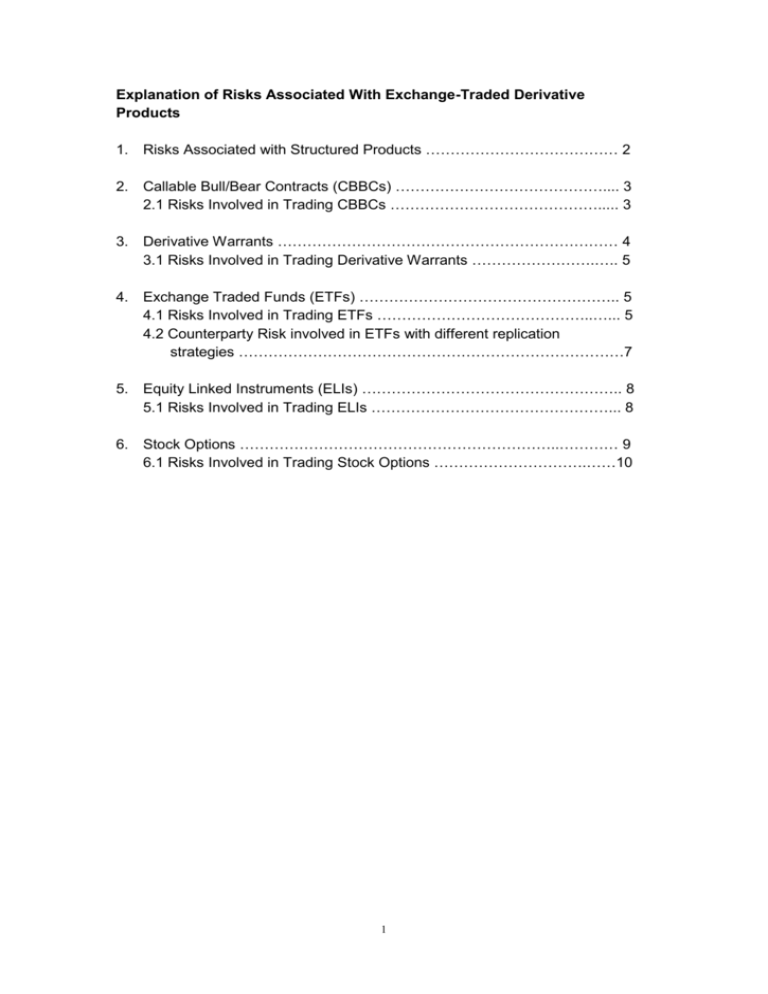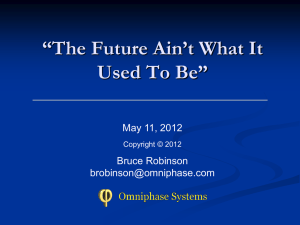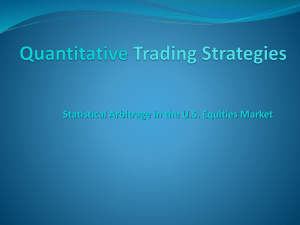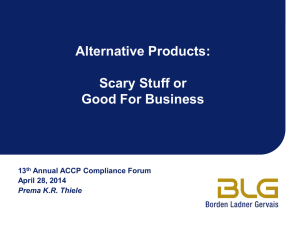Explanation of Risks Associated With Exchange
advertisement

Explanation of Risks Associated With Exchange-Traded Derivative Products 1. Risks Associated with Structured Products ………………………………… 2 2. Callable Bull/Bear Contracts (CBBCs) …………………………………….... 3 2.1 Risks Involved in Trading CBBCs ……………………………………..... 3 3. Derivative Warrants …………………………………………………………… 4 3.1 Risks Involved in Trading Derivative Warrants …………………….….. 5 4. Exchange Traded Funds (ETFs) …………………………………………….. 5 4.1 Risks Involved in Trading ETFs ……………………………………..…... 5 4.2 Counterparty Risk involved in ETFs with different replication strategies ……………………………………………………………………7 5. Equity Linked Instruments (ELIs) …………………………………………….. 8 5.1 Risks Involved in Trading ELIs …………………………………………... 8 6. Stock Options ………………………………………………………..………… 9 6.1 Risks Involved in Trading Stock Options ………………………….……10 1 1. Risks Associated with Structured Products 1.1 Expiry considerations Structured products have an expiry date after which the issue may become worthless. Investors should be aware of the expiry time horizon and choose a product with an appropriate lifespan for their trading strategy. 1.2 Gearing risk Structured products, such as derivative warrants and callable bull/bear contracts, are leveraged and their value could change rapidly according to the gearing ratio relative to the underlying assets. Investors should be aware that the value of structured products may fall to zero resulting in the total loss of their initial investment. 1.3 Extraordinary price movements Outside influences such as market supply and demand factors may cause the price of a structured product to deviate from its theoretical price. As a result, actual traded prices can be higher or lower than the theoretical price. 1.4 Issuer default risk A structured product issuer could become insolvent and default on their listed securities and in that event investors will be considered as unsecured creditors and will have no preferential claims to any assets held by the issuer. Investors should therefore pay close attention to the financial strength and credit worthiness of structured product issuers. 1.5 Uncollateralised product risk Uncollateralised structured products are not asset backed. In the event of the bankruptcy of the issuer, investors could lose their entire investment. 1.6 Foreign exchange risk Underlying assets of structured products could be denominated in a currency different from an investor’s base currency. Hence, investors are exposed to exchange rate risk. Currency rate fluctuations can adversely affect the value of the underlying asset of a structured product, thereby affecting the price of the structured product. 2 1.7 Liquidity risk Liquidity providers assigned by structured product issuers provide two way quotes to facilitate trading of the products. If a liquidity provider defaults or ceases to fulfill its role, investors may not be able to trade the relevant product until a new liquidity provider has been assigned. 2. Callable Bull/Bear Contracts (CBBCs) Callable Bull/Bear Contracts (CBBCs) are issued either as Bull or Bear contracts with a fixed expiry date, allowing investors to take bullish or bearish positions on the underlying asset. CBBCs are issued by a third parties, usually investment banks, independent of stock exchanges and of the underlying assets. In Hong Kong, CBBCs may be issued with a lifespan of 3 months to 5 years and are settled in cash only. During a CBBC’s lifespan, it will be called by the issuer when the price of the underlying asset reaches a level (known as the “Call Price”) specified in the listing document. If the Call Price is reached before expiry, the CBBC will expire early and the trading of the CBBC will be terminated immediately. 2.1 Risks Involved in Trading CBBCs a) Mandatory call risk Investors trading CBBCs should be aware of their intraday “knockout” or mandatory call feature. A CBBC will cease trading when the underlying asset value equals the mandatory Call Price as stated in the listing documents. Investors will only be entitled to the residual value of the terminated CBBCs as calculated by the product issuer in accordance with the listing documents, and the residual value can be zero. Once the CBBC is called, even though the underlying asset may bounce back in the right direction, the CBBC which has been called will not be revived and investors will not be able to profit from the bounce back. In general, the larger the buffer between the Call Price and the Spot Price of the underlying asset, the lower the probability of the CBBC being called since the underlying asset of that CBBC 3 would have to experience a larger movement in the price before the CBBC will be called. However, at the same time, the larger the buffer, the lower the leverage effect will be. b) Trading of CBBC close to Call Price When the underlying asset is trading close to the Call Price, the price of a CBBC may be more volatile with wider spreads and uncertain liquidity. CBBC may be called at any time and trading will terminate as a result. However, the trade inputted by the investor may still be executed and confirmed by the investors after the Mandatory Call Event (MCE) since there may be some time lapse between Mandatory Call Event time and suspension of the CBBC trading. Any trades executed after the MCE will not be recognized and will be cancelled. Therefore, investors should be aware of the risk and ought to apply special caution when the CBBC is trading close to the Call Price. c) Funding costs The issue price of a CBBC includes funding costs, which are gradually reduced over time as the CBBC moves towards expiry. In the event that a CBBC is called, investors will lose the funding costs for the remaining period of the CBBC. 3. Derivative Warrants Derivative warrants are an instrument that gives an investor the right, but not the obligation, to “buy” or “sell” an underlying asset at a pre-set price (also known as the exercise price) within a certain time period following a valid exercise. They may be bought and sold prior to expiry in the market. For derivative warrants traded in Hong Kong, they are usually settled at expiry in cash. In some markets, derivative warrants may be exercised at or prior to expiry by purchase or sale of the underlying asset. Derivative warrants may be issued in American or European styles. Holders of American-style derivative warrants may exercise at any time prior to expiry while holders of European-style derivative warrants may only exercise on the expiry date. Derivative warrants can be issued over a range of assets, including stocks, stock indices, currencies, commodities, or a basket of securities. They are 4 issued by a third party, usually an investment bank, independent of the issuer of the underlying assets. Derivative warrants traded in Hong Kong normally have an initial life of six months to two years and when trading in the market each derivative warrant is likely to have a unique expiry date. 3.1 Risks Involved in Trading Derivative Warrants a) Time decay risk All factors being equal, derivative warrant value will decay over time as it approaches expiry. Derivative warrants would have no value upon expiry and should not be viewed as a long term investment. b) Volatility risk Prices of derivative warrants may or may not increase or decrease in line with the implied volatility of underlying asset price. Investors should be aware of the volatility of the underlying asset. 4. Exchange Traded Funds (ETFs) Exchange Traded Funds (ETFs) are passively managed open-ended funds traded like stocks on the exchanges. In Hong Kong, all listed ETFs are authorized by the Securities and Futures Commission as collective investment schemes. ETFs track, replicate or correspond to the performance of the underlying benchmarks (e.g. an index, specific segment of a market, bonds or commodities) and offer investors an indirect access to a wide range of underlying market themes. By investing in an ETF, investor can replicate (although not 100%) the performance of the underlying strategy without actually owning the constituents that comprise the strategy. ETFs may or may not pay dividend to their holders depending on the dividend policy of individual ETFs. 4.1 Risks Involved in Trading ETFs a) Market risk An ETF is exposed to the economic, political, currency, legal and 5 other risks of a specific sector or market related to the index and the market that it is tracking. b) Tracking error risk This is the disparity between the performance of the ETF and the performance of the underlying benchmark. Tracking error may arise due to various factors such as changes in the composition of the underlying benchmark and type of ETF (e.g. physical vs synthetic), failure of the ETF’s tracking strategy, impact of fees and expenses, foreign exchange differences between the base currency or trading currency of the ETF and the currencies of the underlying investments. c) Risk in trading at discount or premium to NAV As the trading price of the ETF is typically determined by the supply and demand factors, the EFT may trade at a price higher or lower than its Net Asset Value (NAV). In the case when the ETF is terminated, investors who bought at a premium may suffer a loss and would not be able to recover it through the fund. d) Foreign exchange risk Investors trading ETFs with underlying assets not denominated in their same local currency are exposed to exchange rate risk. Currency rate fluctuations can adversely affect the value of the underlying asset of an ETF, thus affecting the price of the ETF. e) Liquidity risk Market makers help to provide liquidity to facilitate trading in ETFs. Although most ETFs are supported by one or more market makers, there is no assurance that active trading will be maintained. In the event that the market makers default or cease to fulfill their role, investors may not be able to buy or sell the ETF or may find the market price of the ETF is at a discount or premium to its NAV. f) Stock lending risk An ETF which engages in stock lending faces the risk that the borrower may not return the securities lent by the ETF as agreed, and thus the ETF may experience losses due to its stock lending activities. 6 4.2 Counterparty Risk involved in ETFs with different replication strategies a) Full replication and representative sampling strategies Under a full replication strategy, an ETF generally aims to invest in all constituent stocks/assets in the same weightings as its benchmark. Under a representative sampling strategy, an ETF invests in some, but not all of the relevant constituent stocks/assets. For ETFs that invest directly in the underlying assets rather than through synthetic instruments issued by third parties, counterparty risk tends to be less of concern. b) Synthetic replication strategies Synthetic ETFs may invest in over-the-counter derivatives issued by counterparties and thus may suffer losses potentially equal to the full value of the derivatives issued by a counterparty upon its default. Hence, synthetic ETFs are exposed to both the risks of the underlying stocks / assets as well as the default risk of the counterpart that issues the financial derivative instruments for replicating the performance of the index. Some synthetic ETFs may invest in financial derivatives issued by a number of counterparties to diversify counterparty credit risk concentration. However, the more counterparties an ETF has, the higher the mathematical probability of the ETF being affected by a counterparty default which may lead to losses to the ETF. Synthetic replication ETFs can be further categorized into two forms: (i) Swap-based ETFs: ETF managers may replicate the benchmark performance through total return swaps without purchasing the underlying assets. Swap-based ETFs would expose to counterparty risk of the swap dealers and may suffer losses if such dealers default. (ii) Derivative embedded ETFs: ETF managers may synthetically replicate the economic 7 benefit of the relevant benchmark by the use of other derivative instruments. These instruments may be issued by one or multiple issuers. Derivative embedded ETFs would expose to counterparty risk of the instruments’ issuers and may suffer losses if such issuers default. Further, potential contagion and concentration risks of the derivative issuers should be taken into account (e.g. since derivatives issuers are predominantly international financial institutions, the failure of one derivative counterparty of a synthetic ETF may have a “knock-off” effect on the other derivatives counterparty of a synthetic ETF. Some ETFs may acquire collateral, but it may subject to counterparty risk if the collateral provider is not fulfilling its obligations. There is a further risk that when the right against the collateral is exercised, the market value of the collateral could be substantially less than the amount secured resulting in significant loss to the ETF. 5. Equity Linked Instruments (ELIs) Equity Linked Instruments (ELI) are structured products which are marketed to investors who want to earn a higher interest rate than the rate on an ordinary time deposit and accept the risk of repayment in the form of the underlying shares or losing some or all of their investment. When an investor purchases an ELI, he is indirectly writing an option on the underlying shares. If the market moves as the investor expected, he earns a fixed return from his investment which is derived mainly from the premium received on writing the option. If the market moves against the investor's view, he may lose some or all of his investment or receive shares worth less than the initial investment. 5.1 Risks Involved in Trading ELIs a) Possibilities of losing investment Investors may lose part or all of their investment if the price of the underlying security moves against their investment view. b) Exposure to equity market 8 Investors are exposed to price movements in the underlying security and the stock market, the impact of dividends and corporate actions and counterparty risks. Investors must also be prepared to accept the risk of receiving the underlying shares or a payment less than their original investment. c) Price adjustment Investors should note that any dividend payment on the underlying security may affect its price and the payback of the ELI at expiry due to ex-dividend pricing. Investors should also note that issuers may make adjustments to the ELI due to corporate actions on the underlying security. d) Potential yield Investors should consult their brokers on fees and charges related to the purchase and sale of ELI and payment / delivery at expiry. The potential yields disseminated by the Hong Kong Stock Exchange have not taken fees and charges into consideration. e) Interest rates While most ELIs offer a yield that is potentially higher than the interest on fixed deposits and traditional bonds, the return on investment is limited to the potential yield of individual ELIs. 6. Stock Options A stock option is a financial contract based on single underlying stock which is traded on an exchange and cleared through its clearing house. The two major types of option contracts are call option and put option. A call option buyer has the right (but not obligated) to buy the underlying stock at the strike price (i.e. pre-determined price) on or before the expiry day, while a call option seller (also known as the writer) has the obligation to sell the underlying stock at the strike price upon exercise on or before the expiry day. A put option buyer has the right (but not obligated) to sell the underlying stock at the strike price on or before the expiry day, while a put option seller has the obligation to buy the underlying stock at the strike price upon exercise on or before the expiry day. 9 6.1 Risks Involved in Trading Stock Options a) Variable degree of risk Transaction in stock options carries a high degree of risk. Purchasers and sellers of stock options should familiarize themselves with the type of option (i.e. put or call) which they contemplate trading and the associated risks. Investors should calculate the extent to which the value of the stock option must increase for investors’ position to become profitable, taking into account the premium and all transaction costs. The purchaser of stock option may offset or exercise the stock option or allow the stock option to expire. The exercise of a stock option results either in a cash settlement or in the purchaser acquiring or delivering the underlying interest. If the purchased stock options expire worthless, the purchaser will suffer a total loss of the purchaser’s investment which will consist of the stock option premium plus transaction costs. If investors are contemplating purchasing deep-out-of-the-money stock options, investors should be aware that the chance of such stock options becoming profitable ordinarily is remote. Selling (“writing” or “granting”) a stock option generally entails considerably greater risk than purchasing a stock option. Although the premium received by the seller is fixed, the seller may sustain a loss well in excess of that amount. The seller will be liable for additional margin to maintain the position if the market moves unfavourably. The seller will also be exposed to the risk of the purchaser exercising the stock option and the seller will be obligated to either settle the stock option in cash or to acquire or deliver the underlying interest. If the stock option is “covered” by the seller holding a corresponding position in the underlying interest or another stock option, the risk may be reduced. If the stock option is not “covered” (also known as “naked”), the risk of loss can be unlimited. Certain exchanges in some jurisdictions permit deferred payment of the option premium, exposing the purchaser to liability for margin payments not exceeding the amount of the premium. The 10 purchaser is still subject to the risk of losing the premium and transaction costs. When the option is exercised or expires, the purchaser is responsible for any unpaid premium outstanding at that time. b) Terms and conditions of stock option contracts Investors should ask the firm with which investors deal about the terms and conditions of the specific stock option which investors are trading and associated obligations (e.g. expiration dates and restrictions on the time for exercise). Under certain circumstances the specifications of outstanding contracts (including the exercise price of an options) may be modified by the exchange or clearing house to reflect changes in the underlying interest. c) Suspension or restriction of trading and pricing relationships Market conditions (e.g. illiquidity) and/or the operation of the rules of certain markets (e.g. the suspension of trading in any contract or contract month because of price limits or “circuit breakers”) may increase the risk of loss by making it difficult or impossible to effect transactions or liquidate/offset positions. If investors have sold options, this may increase the risk of loss. Further, normal pricing relationships between the underlying interest and the option may not exist. This can occur when, for example, the interest underlying the option is subject to price limits while the option is not. The absence of an underlying reference price may make it difficult to judge “fair value”. The above explanatory statement does not disclose or explain all of the risks and other significant aspects of trading in derivative products. In light of the risks, an investor should not engage in trading in derivatives unless the investor understands the nature of the transactions into which the investor is entering and the extent of the investor's exposure to risk. An investor should carefully consider whether trading in derivatives is appropriate for him in light of the investor's investment experience, objectives, risk appetite, financial resources and other relevant circumstances. If in doubt, investors are strongly advised to seek independent and professional advice from legal, tax, financial and other professional advisers. Whilst care has been taken in the preparation of this document, no responsibility is accepted for the completeness, adequacy 11 or accuracy of its contents. To learn more, you may visit the websites of Hong Kong Exchanges and Clearing Limited (http://www.hkex.com.hk) and the Securites and Futures Commission of Hong Kong (http://www.sfc.hk). 12






